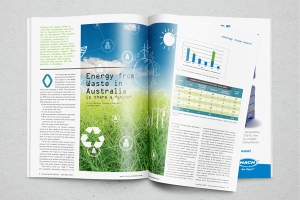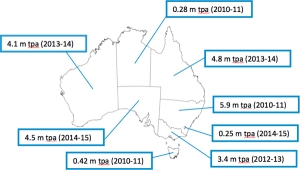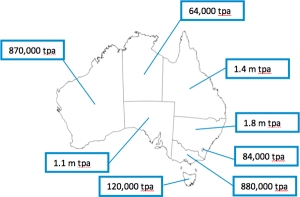Energy from Waste in Australia – is there a future?
 By Ron Wainberg – Technical Director, MRA Consulting Group
By Ron Wainberg – Technical Director, MRA Consulting Group
Energy from Waste (EfW) is very well established overseas, but in Australia it has yet to get off the ground. The reasons for this are to be found in a complex combination of different historical factors: adequate landfill capacity, poor financial incentives, unfavourable public perceptions and lack of Government policy support. While these are changing, they have combined in the past to prevent any meaningful EfW projects from gaining traction. But the position is changing.
Over 10 years ago, the Federal Government provided financial support to the Waste Management Association of Australia to develop an ‘EfW Sustainability Guide’, which was finalised in 2005. The document was the result of extensive nationwide consultation, and represented a starting point to put EfW back on the agenda by outlining some basic principles and a process for assessing EfW proposals, such as:
- Does recovering energy from the proposed fuel represent the best use of that material at that place and time?
- Is the process efficient?
- Will environmental outcomes be controlled?
- What will be the social outcomes?
- Are controls in place to ensure the stated outcomes will be achieved?
- Will the project work financially?
These questions are largely common sense, but they needed to be clearly stated because at the time EfW was a no-go zone in Australia. Given the slow progress since then, it is easy to conclude that these efforts may have been forgotten.
To be fair, Australia does recover some energy from its wastes. As shown in Figure 1 there are over 60 installations feeding electricity derived from waste into the national grid [1].
Figure 1 – Number of facilities connected to grid by feedstock type
 However, the majority of these systems (which exclude anaerobic digestion systems) are based on the combustion of landfill gas and bagasse, a by-product of sugar production. The potential to recover energy from the bulk urban solid waste stream is largely ignored.
However, the majority of these systems (which exclude anaerobic digestion systems) are based on the combustion of landfill gas and bagasse, a by-product of sugar production. The potential to recover energy from the bulk urban solid waste stream is largely ignored.
The scale is small too. Table 1 [2] shows the nameplate generating capacity of the EfW facilities. The total power generated is only 623MW.
Table 1 – Nameplate capacity of EfW facilities connected to distribution networks
| State | Nameplate Capacity by Fuel Type (MW) | Total (MW) | |||
| LFG | Municipal/Industrial biomass |
Bagasse | Sewage/ Wastewater |
||
| NSW & ACT | 57 | 4 | 68 | 0 | 129 |
| VIC | 50 | 0 | 0 | 2 | 52 |
| WA | 20 | 40* | 0 | 0 | 60 |
| SA | 13 | 0 | 0 | 0 | 13 |
| QLD | 14 | 30* | 320 | 0 | 364 |
| TAS | 5 | 0 | 0 | 0 | 5 |
| Total | 159 | 74 | 388 | 2 | 623 |
*Wood waste generation plants
More facilities are proposed to treat urban wastes, as shown in Table 2. These amount to around 200MW generation capacity with a capital investment of nearly $1.5 billion.
Table 2 – Thermal Facilities in Pipeline or Proposed
| Proponent | Proposed Location |
Estimated Cost |
Waste feedstock (tpa) |
Energy Outputs (MW) |
| New Energy | Port Hedland (WA) | $180 million | 60,000 | 15 |
| New Energy | East Rockingham (WA) | $160 million | 225,000 | 18.5 |
| Phoenix Energy | Kwinana (WA) | $380 million | 400,000 | 32 |
| EMRC | Hazelmere (WA) | $25 million | 13,000 wood waste | 3.5 |
| Dial-a-Dump | Eastern Creek (NSW) | $700 million | 1,200,000 | 140 |
| City of Sydney | Sydney (NSW) | Unknown | 42,000 MSW (minimum) | Unknown |
In addition, there are a number of facilities being planned to manufacture Refuse Derived Fuel or RDF (sometimes referred to a Process Engineered Fuel, or PEF). These fuels are generally targeted at the export market. Only the RecourceCo facility in Adelaide produces a fuel which is used locally, in cement production and not power generation.
Australia currently sends around 23 million tonnes for urban waste to landfill. The breakdown state by state is shown in Figure 2, but not all of it would be suitable as fuel.
Figure 2 – Waste to Landfill in Australia

The portion of the landfilled waste which would be suitable as a fuel (plastics, paper and cardboard, wood and textiles is estimated to be approximately 6.3 million tpa [3]. The nationwide distribution of these ‘fuels’ is shown in Figure 3. While additional materials in the waste could be used as a fuel, it would be at the expense of established resource recovery and recycling operations. This may prove to be a major issue for proponents seeking to justify EfW with the regulatory authorities as well as environmental stakeholders and the general public. It is worth remembering the Sustainability Guide from 2005.
Figure 3 – Potential fuels in urban solid waste

The calorific value of the ‘fuel’ currently being landfilled is estimated to be 63 million GJ per annum. If the material is used for electricity production it would generate around 13 GJ per annum of power (assuming 20% efficiency). Australia’s electricity consumption in 2014-15 was 700 million GJ, so the potential to supply energy from Australia’s urban wastes represents around 2% of the annual demand.This is very much a “back of the envelope” analysis, but it does demonstrate a need to keep EfW in perspective from the point of view of the power generation industry.From a waste and resource management perspective on the other hand, EfW will be vital if the high rates of landfill diversion targeted by State Governments are to be achieved.
The waste industry has very different drivers to energy generation. Increasing landfill charges, decreasing landfill volume, the difficulties in gaining community acceptance of new landfill sites, together with a broad community expectation to do more than simply bury waste, are driving the search for alternative waste management approaches. Given these factors, it simply does not make sense to bury things which have a recoverable energy content, but have no viable alternative option for recovering their material value.EfW is not cheap.
While a direct comparison needs to be treated with caution, UK gate fees [4] for EfW range from $130 – $264 per tonne. The high cost of landfill in most Australian states, especially NSW, means that the financial viability of EfW is improving. This is exactly what the landfill levy was originally designed to achieve.So, apart from price, what are the impediments? Why is the recovery of energy form urban waste in Australia not further developed?The answer lies in all the other hurdles which need to be overcome to get EfW off the ground:
- The need for a clear Government policy. Victoria has published Guidelines, WA has a Position Statement and NSW has a very restrictive Policy. The other jurisdictions are silent. A clear set of national Guidelines, supported by all jurisdictions would be preferable so that proponents and their financiers know exactly where they stand and what the rules of the game are.
- There has to be a market for the outputs. Unless there is a use for the power (or heat, or RDF) produced through EfW, the project’s viability will be challenging.
- Unless the power generated is for internal use, the EfW facility must be connected to the national grid and a power purchase agreement established with an energy distributer. This can be a long and expensive process, and given the relatively small contribution EfW will make to a market which is presently oversupplied, it is easy to understand the reluctance of energy providers to become involved.
- A site will be needed for an EfW facility. This site will require development approval and appropriate licencing. Satisfying these requirements can be a lengthy and expensive process.
- The EfW facility must comply with air emissions regulations. This is not negotiable and can represent a significant portion of the overall facility cost. It also means that a degree of quality control must be applied to the “fuel” in order to keep contaminants within acceptable limits.
- There must be community acceptance of the facility. Community consultation must be commenced early and be both sustained and transparent. Past experience has taught that if this is not achieved, the difficulties facing the project will escalate dramatically. Ensuring and demonstrating that EfW does not cannibalise resource recovery will be an important consideration.
- There needs to be a secure source of fuel for the facility, and guaranteed quantities, if project is to gain financial closure. This is more complex than it sounds. While “waste” represents unwanted stuff, it’s collection and management is controlled by Local Governments (Municipal Waste) and a relatively small group of waste collectors (Commercial & Industrial and Construction & Demolition Waste). There is an existing network of commercial arrangements which manages these materials and “owns” the feed and products. Gaining access to the required quantities of the right materials will involve significant commercial negotiations.
None of these issues need to be show-stoppers, but they do need to be considered by proponents. The success of the project will depend on heeding lessons learned in the past, receiving the right advice, and above all, patience.As always, MRA welcome your feedback on this article, or any other topic on ‘The Tipping Point’.
[1] AEMO 2015 and WA Department of Finance 2015.
[2] Ibid.
[3] Based on generic waste composition data.
[4] UK WRAP Gate Fees Report 2015.



